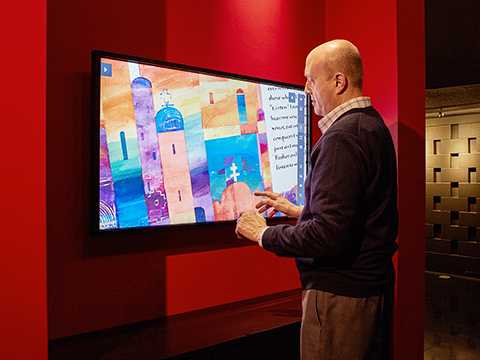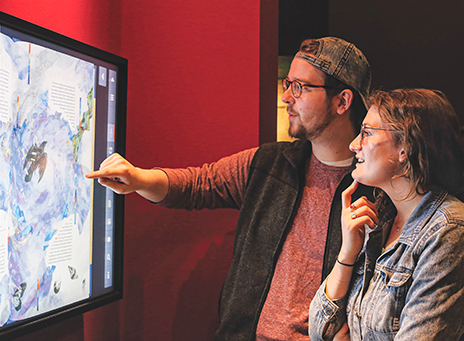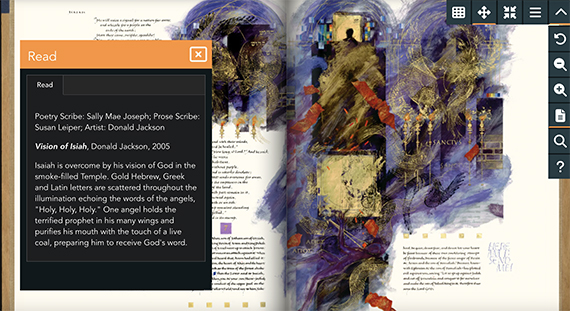Turning the Pages: Fine Art Made Accessible
In May of 2025, The Saint John’s Bible launched Turning the Pages. The launch marked a new era in the life of the work of sacred art and scripture, one in which anyone in the world could experience it from their phone, tablet, or computer screen.
“From the very beginning, the purpose of Turning the Pages was to get The Saint John’s Bible into as many hands as possible,” said Tim Ternes, director of The Saint John’s Bible at the Hill Manuscript Museum and Library (HMML). “The Bible is communal. It’s meant to be shared. We wanted a way to make this accessible to anyone who wants it.”

“Turning the Pages has always been about access,” said Jagjit Rooprai, Director of Armadillo Systems. “Usually, rare books and manuscripts live in a temperature-controlled glass cabinet where people in the real world don’t get to experience it. What Turning the Pages does is provide access to these monumental works, so anyone can see them in detail that you might not even be able to see in their physical form. That’s the reason why I love doing what we’re doing.”
Armadillo Systems, a digital agency based in London, is the company that created Turning the Pages. Ternes first encountered Armadillo’s work at the British Library in London, where Armadillo had created a digital version of some of the Library’s greatest manuscripts, such as the Lindisfarne Gospels. “I remember thinking, this is fantastic,” said Ternes. “We need to do this with The Saint John’s Bible.”
The first step of the process was to digitize each page of The Saint John’s Bible. Luckily, the project’s creators had the foresight to digitize individual pages as they were created.
Wayne Torbog, Director of Digital Collections and Imaging at the Hill Manuscript Museum and Library, was the artist in charge of digitizing each page, usually within a week after the pages arrived in Minnesota. Digitizing a vellum piece is much more complex than any other 2D medium. This is because, immediately after the skin leaves its conservation area, it starts to expand and contract in response to the heat. Even though he was working with pages that were, in a sense, alive and moving, Torborg created beautifully digitized images of the pages.
Another nuance of this project came from its length. Because 11 years passed between scribing the very first word to the last, and because technology evolved drastically between 2000 and 2011, the capture quality varies between the volumes.
“The very first volumes from 2000 were digitized with a capture that took 20 minutes,” said Ternes. “The last volumes were done with an instant capture.”

In this way, Turning the Pages serves as a historical capture of the change in digitization technology as The Saint John’s Bible progressed through completion. That being said, Armadillo’s expertise allowed for the software to showcase digital quality of an elite caliber. In 2016, Armadillo created a brand-new ultra-high definition 4K version of Turning the Pages that would allow for the digitized illuminations to appear in an unprecedented amount of detail, even compared to the human eye.
“This advancement enables the user to see these images in much greater detail than they could in the previous iteration,” said Rooprai. “That means that you can zoom in very closely to the images. The Saint John’s Bible was the catalyst for us to develop this new arm to our Turning the Pages software.”
For context, close means really close. Users can zoom in to individual letters on the script in Turning the Pages and see the precise edges where the calligrapher’s ink left the page.
“When you can experience the script and illuminations in this way, and in this great detail, you really start to see the individual characteristics of the letters. You can understand how every letter started in the artist’s toes and travelled through to their fingers,” said Ternes.
The developers at Armadillo even figured out how to make the digital pages sparkle when you turn them, just as they would reflect against the light in real life.
“Donald Jackson came into the Armadillo office one day to see the progress, and he was so excited,” said Rooprai. “He mentioned how, normally, you can never really see the detail that he and the other artists put into the script. He couldn’t actually believe that on the digital version, he could see details that sometimes people don’t even see when they look at the pages. That was really amazing for us to hear and probably some of the best feedback we’ve ever received.”
“Most of the books we do are medieval manuscripts, and that was the first time we had ever met a living artist behind one of the books we’ve done,” said Steve Kennett, Software Developer at Armadillo Systems. “Sometimes I wonder what the monks back in the Sherborne Abbey, for example, would have thought of their book being reproduced on a glowing screen in the future.”
Didactics: Uncovering Secrets in the Bible
To further enhance the digital expression of The Saint John’s Bible, Ternes worked with Armadillo to create didactics for every single page. To do this, he compiled labels and text that were originally created to accompany museum exhibitions of The Saint John’s Bible, plus notes, sketches, and artist’s commentary from when the original manuscript was being created.

“We have the tools, the scraps, the notes, all the sketches, and the commentary that the artists wrote about their pages when they presented them to the committee, plus the committee’s comments,” said Ternes. “I took that source material to create the didactics. Most of what you see in Turning the Pages comes from the actual words of the artists and the committee members.”
How Will People Use Turning the Pages?
Since The Saint John’s Bible is still in its digital infancy, the full gamut of how it will be used is largely unexplored – but Ternes believes the possibilities are endless.
“Personally, I use it almost every single day in the gallery at HMML. We can only display a certain number of pages at a time, so the digital version helps us push conversations with guests even further as they explore The Saint John’s Bible,” said Ternes. “I imagine people will use it individually for exploration, in a church setting using a projector for worship or Bible study, in a classroom for university study and research, and I can even see private owners of The Saint John’s Bible Heritage Edition displaying the digital expression on a kiosk in their home galleries.”
“I hope somebody emails me and says, ‘Here’s what we’ve done with Turning the Pages. Have you thought about this?’” said Ternes. “I so look forward to all of the creative ways people will engage with it.”
The Saint John’s Bible encourages Turning the Pages users to email Tim Ternes at TTERNES@csbsju.edu with a description of how they used the platform.
The Saint John’s Bible: Extending the Invitation
To read more stories similar to this one, visit the blog on www.saintjohnsbible.org and subscribe to our monthly e-newsletter, Sharing the Word.

